|
Not your ordinary adventure game of late...
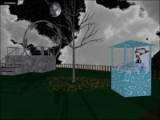 There is no voice-acting or cutscene to roll your eyes over, no illogical storyline to fume at, no rich, graphic marvels to admire. No sound puzzles that sound alike, no boring and long journals and books to read. There's no one to kill, and nothing will harm you.
There is no voice-acting or cutscene to roll your eyes over, no illogical storyline to fume at, no rich, graphic marvels to admire. No sound puzzles that sound alike, no boring and long journals and books to read. There's no one to kill, and nothing will harm you.
Instead, the first game from a Canadian game developer Sagewood Software will give you almost infinite permutations of situations on 9 different worlds, out of which you get to play 5 of them each time. Scavenger Hunter is a unique, replayable adventure game.
Introduction to the Game
The game is set, so I've figured from Sagewood's website, sometime in the near future. The human beings on the planet Earth are not alone in the universe any more. They are not alone either in suffering from mysterious disappearance of valuable artifacts; it turns out to be a galaxy-wide problem for centuries. An alien race called "The Scavengers" are responsible for the theft, and now Inter Universe Insurance Corporation has set up an elite group of people (terrans and aliens) to hunt down and retrieve the stolen objects and destroy the Scavengers' worlds so that they cannot come pilfering the valuable objects again. Each of these worlds is powered and sustained by a crystal, which the Scavengers guard by putting in a cage with a special code to unlock it. To destroy their worlds, you have to destroy their crystals in the Alien Control Room.
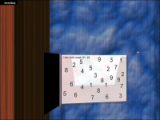 You will play as an agent attached to this elite taskforce. You will be assigned 5 different worlds; after picking up the scanner, the stolen item list, and a bag to put the items in the office, you are ready to go. For your effort, you will get 10% cut of the value of the artifacts that you recover, plus 15% of that amount if you destroy the Scavengers' worlds. So to recap, your mission is:
You will play as an agent attached to this elite taskforce. You will be assigned 5 different worlds; after picking up the scanner, the stolen item list, and a bag to put the items in the office, you are ready to go. For your effort, you will get 10% cut of the value of the artifacts that you recover, plus 15% of that amount if you destroy the Scavengers' worlds. So to recap, your mission is:
1. Retrieve as many stolen objects on the list from these 5 alien worlds you are assigned to;
2. Locate and collect crystals from each world and destroy their worlds in the Alien Control Room.
A door in the insurance office (where you start the game) leads to a portal that will take you to one of the worlds assigned to you. You click on the portal control, which activates the portal. You turn to face the portal, and in you go.
Once in the alien world, you will have to repair broken portals in each world by finding and replacing the blue plasma fuses in the portal control box so you will be able to move freely between the worlds. In order to reach the Alien Control Room to demolish their worlds, you need the special red fuses to power up the special portal. To complete your mission successfully, you are required to be attentive to details, observant, and methodical.
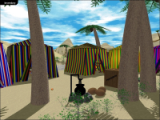 Well, it's cute but it's a kids' stuff, said I, the snooty. What could there be for me to get excited about (and excited enough to write a review about)? It looked like a simple point and click with OK graphics, and it was basically a game to find and collect things... Let's just say I was in for a little surprise.
Well, it's cute but it's a kids' stuff, said I, the snooty. What could there be for me to get excited about (and excited enough to write a review about)? It looked like a simple point and click with OK graphics, and it was basically a game to find and collect things... Let's just say I was in for a little surprise.
Game Mechanics
The Scavenger Hunter is indeed a first-person, point and click game. All scenes are pre-rendered, and you play the game from a predetermined position and angle. Once you are in the alien world, the game is totally non-linear, which I like a lot. You are free to go anywhere, to any world (once you repair the portals); there is no event which should take place before the next sequence is triggered. The exception to this is of course the end game, which only happens after you finish your task in the Alien Control Room.
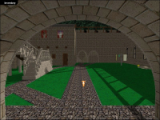 The navigation is very simple and mostly trouble-free: go forward, turn left, turn right, turn around, and occasional look up and look down. Sometimes, if you move the mouse too quickly to show the "turn around" cursor, you may miss the "look down" cursor which, when it appears, is right above the "turn around" cursor.
The navigation is very simple and mostly trouble-free: go forward, turn left, turn right, turn around, and occasional look up and look down. Sometimes, if you move the mouse too quickly to show the "turn around" cursor, you may miss the "look down" cursor which, when it appears, is right above the "turn around" cursor.
The inventory items (your tools and retrieved objects) are readily accessible on top of the screen. While you are exploring the surroundings all you see is the "Inventory" icon in the top left corner. When you need to use the items in the inventory, move the cursor over the "Inventory" icon, and the items will be displayed across the top of the screen.
All the tools that you will need are already given to you once the game starts. You will not need to look for a tool to complete your tasks in the alien worlds. This is nice. It takes out the stress of having to constantly find new tools to do something in a new setting, as it happens frequently in adventure games these days.
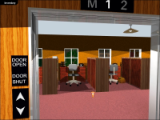 The cursor is mostly accurate, and hot spots are well-defined. You don't need to read the manual to figure out most of the navigation movement and cursor types (I didn't, as usual), but you may want to read how some of the default inventory items are supposed to work. (I didn't read it, and suffered because of it.)
The cursor is mostly accurate, and hot spots are well-defined. You don't need to read the manual to figure out most of the navigation movement and cursor types (I didn't, as usual), but you may want to read how some of the default inventory items are supposed to work. (I didn't read it, and suffered because of it.)
The game has infinite saves, and the saved files are stored in the game program directory as .sav file. The game installs completely on the hard disk, and there is no need to keep the disc in the CD-ROM drive to play the game. The game takes up a sizeable chunk of your hard disk drive, though. Once installed, it is very stable, and loads relatively fast.
Basic Setup of the Worlds
Even though the game boasts almost infinite number of variations, I've noticed that there is a fundamental setup in each world that will not change from game to game. (Of course I could be dead-wrong here, as I haven't played a hundred times yet...)
- In each world, there are at least one, usually two building structures that you get to explore.
- The places you are allowed to explore this time will be the same as the next time. Other hardware, such as landscape, street lights, buildings that you are not allowed in, does not change from game to game.
- The location of the box that contains the crystal cage seems to be the same each time. (However, the crystal cage is not always locked in the box.)
- Anywhere you go, you do not meet any living soul, human or otherwise.
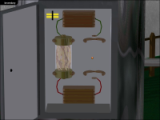 So, what changes in each new game? Here is what I have found so far:
So, what changes in each new game? Here is what I have found so far:
- Different combinations of the 5 worlds out of 9: You will still have at least one world from your previous game, but even in that world, there will be changes in how things are set up.
- Access methods to the buildings in each world: There are three methods of entry that I have found so far. An old-fashioned key, a more modern-looking hole-punched card, and a numeric pad to punch in the entry codes. They are usually somewhere very close to the entrance, so you don't need to go running around all over the world to find the key, card, or codes.
- Codes with numbers and/or symbols are generated new in each new game.
- Different stolen objects will appear in different locations and/or different worlds.
In other words, the look and feel of each world will not change, but details within the world will change from game to game.
Alien worlds
The graphic resolution of this game is 800 x 600, and the scenes are all pre-rendered. Not for admiring realistically rendered worlds, like you may expect these days in adventure games. Frankly, I didn't expect much at all when I saw the picture on the CD sleeve.
The opening scene in the insurance company's office confirmed my rather low expectation. However, as I went through the portal and land on the alien world, I had to admit that the graphic description of each world had a certain irresistible charm, much like the original Myst. All I can say is, see for yourself.
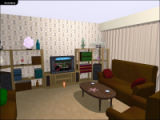 There are currently 9 different worlds to explore and hunt down the stolen objects. Judging from how these worlds are constructed, these light-fingered aliens must really like our lifestyle here on Earth. They have created their worlds replete with buildings that are reminiscent of a good, middle-class neighborhood and household. Stolen artifacts are displayed in good taste, among modest furniture. They keep their yards nice and tidy. Fields, vineyards, orchards are connected by well-tended roads and pathways. It is quite enjoyable and relaxing, as there is no one there in any of the worlds. There is nothing outlandish or "alien-looking" about anything in these worlds. They seem even to use English as the second language.
There are currently 9 different worlds to explore and hunt down the stolen objects. Judging from how these worlds are constructed, these light-fingered aliens must really like our lifestyle here on Earth. They have created their worlds replete with buildings that are reminiscent of a good, middle-class neighborhood and household. Stolen artifacts are displayed in good taste, among modest furniture. They keep their yards nice and tidy. Fields, vineyards, orchards are connected by well-tended roads and pathways. It is quite enjoyable and relaxing, as there is no one there in any of the worlds. There is nothing outlandish or "alien-looking" about anything in these worlds. They seem even to use English as the second language.
I am not being cynical here. For some reason I liked all these worlds that these Scavengers had created. Neat, orderly, not extravagant but charming. Almost made me feel bad about taking back the stolen objects from them. But such sentiment doesn't matter much in this game. The whole purpose of playing this game is not to speculate on alien psychology but retrieve the stolen objects and destroy their worlds. Oh we are such barbarians...
But not to worry. The AI engine of this game makes sure that the destroyed worlds are recreated the next time you start the game, with different objects and different puzzles.
Puzzles
Puzzles in this game are pretty well integrated into the game. They are not overly difficult, and they fall into three categories: how to gain access to a locked door; how to operate a machinery to achieve desired results, finding a piece of information to open a box or lock. The piece of information sometimes takes a form of cryptic poem. Most of the puzzles are solvable without resorting to a walkthrough (which doesn't yet exist, if ever. But there is a hint guide by Sagewood Software that covers the basics.)
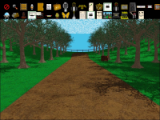 The plasma fuses and stolen artifacts are not purposely hidden. They are out in the open, so to speak, although some of them are stored in a cabinet or safe. All you need to do to find them is to look everywhere carefully and open every door when possible.
The plasma fuses and stolen artifacts are not purposely hidden. They are out in the open, so to speak, although some of them are stored in a cabinet or safe. All you need to do to find them is to look everywhere carefully and open every door when possible.
After a few worlds, you get the hang of different types of puzzles. The difficulty level of the puzzles doesn't seem to go up or down in each new game. (Not that I've noticed so far.) You will be able to zip through a world sooner or later, and the only thing that may keeps you interested in playing the game repeatedly is the different stolen objects and fuses appearing in different places.
Hints
Sagewood Software has a HTML-based hint file you can download. A hint is revealed if you drag your mouse to highlight the seemingly empty space right next to the word "Hint 1 (or 2, 3, etc.)". I used it myself, when I just couldn't locate the red fuses. (Again my usual tendency to not read the instruction first proved almost disastrous; I thought the file was deficient, with no hint at all.) It is not a comprehensive guide, but enough to get you going without getting overly frustrated.
No control over the soundtrack...Agggghh
There is one component of this game that I actively, immensely disliked. It's BGM. Throughout the game, you will hear music. There are several tunes with different instrumentation, but they are all repetitive, and they are played NONSTOP! They really got on my nerves after a while, as it became increasingly difficult to concentrate. Finally I had to turn down the volume on my computer to zero, even if I would miss ambient noise which I'd like to have (sound of a button pushed, creaking of the door, occasional cow mooing, etc.)
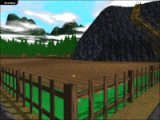 But it could only be me. I am the kind of person who wants to hear music of her own choice and in her own chosen time. Unless the music is integral part of the game (for puzzle solving, or for indicating some imminent disaster) I don't want to be forced to hear it. It would have been nice if music were played only in the first few minutes of entering the new world, and it stopped.
But it could only be me. I am the kind of person who wants to hear music of her own choice and in her own chosen time. Unless the music is integral part of the game (for puzzle solving, or for indicating some imminent disaster) I don't want to be forced to hear it. It would have been nice if music were played only in the first few minutes of entering the new world, and it stopped.
Replayable, but do you want to? Well, you'll never know...
The introduction of the game notwithstanding, there is no storyline to follow, and there is nothing to learn about these Scavengers (other than the fact that they like our stuff). Instead, this game relies on its replayability.
The replayability claim of this game rests on the AI engine that generates near-infinite possibilities of where certain objects and puzzles are placed. The look and feel of each world will not change, but details within the world will change from game to game. To me, this is rather wanting. The game may be replayable, but will the player want to replay? On the second visit to a certain world in a new game, for example, I'd love to have some new places opened up for exploration, different levels of puzzles, even the change of weather and vegetation. After all, having their worlds destroyed, wouldn't the Scavengers decide to fortify their worlds so that they wouldn't be so easily destroyed next time?(I know I am asking too much as a non-programmer...)
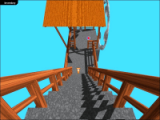 That said, I freely admit I much enjoyed playing the Scavenger Hunter. Actually I am still playing to see what other worlds I can get, and what new artifacts I can find. (Well, so much for what I just said in the previous paragraph...) There is something to be said about hunting for treasure; it is very addictive, whether it is in the game or in the real world.
That said, I freely admit I much enjoyed playing the Scavenger Hunter. Actually I am still playing to see what other worlds I can get, and what new artifacts I can find. (Well, so much for what I just said in the previous paragraph...) There is something to be said about hunting for treasure; it is very addictive, whether it is in the game or in the real world.
Also, in the deluge of adventure games that may have realistic and highly atmospheric graphics but absolutely bomb because of the lousy storyline, lousy script and voice-acting, and boring, illogical puzzles, the Scavenger Hunter's simple, uncomplicated setup is refreshing. You can explore, collect objects, solve puzzles at your own pace. Graphics may not be cutting-edge, but still good enough to keep you interested. With no profane language and no blood and gore, the game is suitable for players of all ages. The only requirement would be that you should be able to read English and do basic calculations (add, subtract, multiply, and divide).
My final score is 81. Despite my misgivings about replayability, I think you will still enjoy playing this game - a nice break from high-feature, high-pressure games. As for myself, I am certainly looking forward to having more worlds to explore, as I have glimpsed in a booklet during the game. (And I do hope they can do something about the music...) In this issue, you can also read the interview with Anne Gregory, the owner of Sagewood Software who created this game.
|
